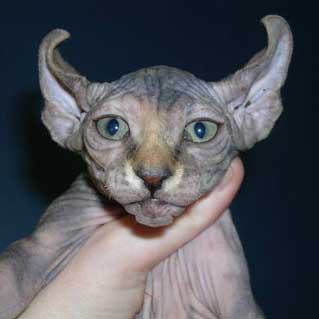
NOTICE – PLEASE READ THIS INTRO: This article is long and Google wants me to shorten it. I have therefore divided it up into several shorter pages. All the information is remains. But it means that the contents at the begin no longer work. I have kept them so that you can see how I have categorised the page. You’ll see pagination links at the base of each section on separate pages. Please click them to move to the next page. Thanks, and sorry for the inconvenience but this article was written years ago when the internet was an entirely different place.
Contents (note these links no longer work as the page is now divided up):
Introduction – on page one
This section goes over the issues in trying to find the rare breeds.
Fringe cat breeds
This section lists some very little-known cat breeds, some current and some variants. Lesser-known cat breeds or emerging cat breeds are bound to be the rarest,
Criteria for selecting rare cats from mainstream breeds
I have devised a new, common-sense criteria based on information freely available.
List of rare cat breeds
This is a list of the more established domestic cat breeds with the rare ones picked out.
Conclusions
This section sets out some conclusions and thoughts on the results.
Sources
List of sources for this article
This page contains guidelines on rarity, popularity and numbers of breeders.
The world’s rarest cat wild or domestic is probably the Borneo Bay Cat
Date of post: early 2008. Remember things are always changing but this page remains accurate 4 years later in 2013. The criteria for deciding which are the rare cat breeds is easy, on the face of it. They will be the cat breeds with the least number of cats. However, it is not as easy as that but it is possible to discover the rare cat breeds with a satisfactory level of usefulness using common sense methods.
At one time there was very little about rare cat breeds on the ‘net despite the fact that if something can be done it is done a lot on the internet. That was the case at 2008! Things have changed in 2013, probably because people followed the ideas presented on this page. There are now many more pages on the subject.
There needs to be an approach that has a degree of science in it. The first hurdle is to decide what a cat breed is. For the purpose of this exercise I am confining myself to domestic cat breeds. A cat breed is obviously a part of the classification of domestic cats. The point is, upon whom do we rely to make the classification? The associations have different ideas (see below) and some breeds are rare and have been classified by people (or a person) other than recognized bodies.

Above Photo of Elf Cat: copyright Kristen Leedom – this cat is not recognized by the cat associations (at 2008) and has only recently been created. This cat is bound to be rare therefore. Note: update years later: I think this new breed is no defunct.


I have a Tennessee Rex a new breed in development with Tica. It features the new to cat fancy satin coat mutation. The satin coat is as it sounds shiny like silk or satin and soft like a cashmere sweater.
Rare cat breeds are actually normally no more expensive than the more common breeds. Some are rare because they are not popular so very few are bred by breeders. If they are not popular that forces the price down.
I hope you are well Darlene. Nice to hear from you.
so is that why most rare breeds of cats can be not cheap at all to purchase one? my first cat was a maine coon cat but i didn’t have to pay to much money for her because i adopted her from a humane society
Natasha, could you capture a picture?
If this cat seems relatively harmless, PLEASE don’t call animal control. That would mean certain death.
It has super large ears in the moonlight the silhouette is beautiful. We don’t feel threatened. But if its rare wanted to make sure its preserved safely. But I have never seen a cat as big or have those directional tall ears.
Personally I wouldn’t call animal control because if the cat is doing no harm it may end up being killed. Large Savannah cats (F1-F2) are rare so probably not that. Could be a large tabby cat. He/she may be an outdoor cat roaming widely. Personally, I’d watch and wait. No harm done. I don’t see any danger. Large domestic cats and even small wild cats aren’t a danger to people. It is the opposite.
I’d be carefully about catching it because someone might own the cat. Technically it could be theft to catch a cat and take it away.
But of course each person has their own way of dealing with things. My style is to live and let live unless you have to take action.
Thanks for asking.